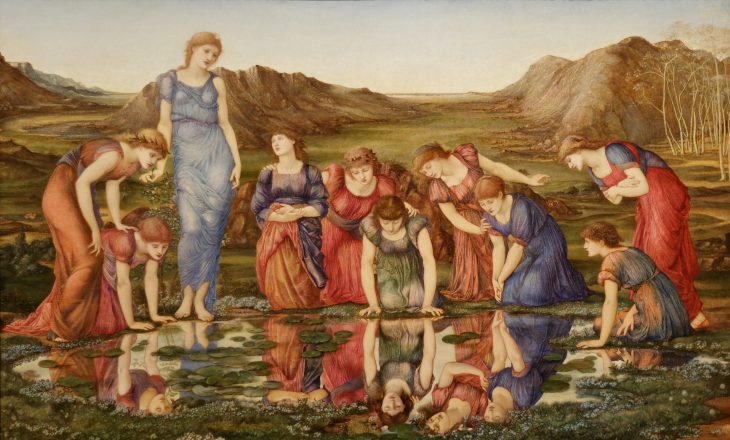A passage in Oscar Wilde’s 1889 dialogue ‘The Decay of Lying’ attempts to distinguish between looking and seeing: ‘To look at a thing is very different from seeing a thing. One does not see anything until one sees its beauty.’ The ability to apprehend beauty and so truly to see, however, is not a question of intuition but of influence: ‘[…] what we see, and how we see it, depends on the Arts that have influenced us’. Wilde’s aesthetic paradoxes are quoted towards the end of Elizabeth Prettejohn’s fascinating new book. Their insights, though, animate the whole of her study’s attempt to help us see, and not just look at, an array of British paintings from the mid 19th through to the early 20th century. Much of the art of this period was, Prettejohn shows, enlivened by a keen sense of the need not to break with the past, but be influenced by it. Counter-intuitively, beauty and originality were to be discovered through imitation.
Portrait of Giovanni (?) Arnolfini and his Wife (1434), Jan van Eyck. National Gallery, London
Returned to such a state of potent mystery by Prettejohn, for instance, is Jan van Eyck’s Arnolfini Portrait (1434). On entering the National Gallery in 1842, it was nearly a century older than any other painting then in the collection. Little was known about its creator and less still about its subject. Over the next half century, there was a long sequence of imitations of aspects of the painting. To understand why it exercised such a ‘talismanic allure’ for 19th-century artists, Prettejohn points to the painting’s striking realism and remarkable state of preservation – in contrast to many of the recent and already deteriorating oil paintings then also displayed in Trafalgar Square. She argues that Charles Eastlake’s conjectures in the 1840s about the Flemish Primitives’ techniques, also recounted by John Ruskin, offered inspiration to the incipient Pre-Raphaelite Brotherhood. As its members sought to reform modern painting, ‘Theirs was a rebellion based not on licence but rather on its opposite, a self-discipline verging on asceticism; it was not a bid for liberation from precedent, but rather an exercise in fidelity.’
Allied to the Arnolfini Portrait’s technical power was also the suggestiveness of its famous mirror, imitated in works ranging from a William Holman Hunt drawing of 1850, illustrating Tennyson’s ‘The Lady of Shalott’, to The Mirror by William Orpen (1900). Alluding to the older painting in various ways became a means of meditating on the nature and limits of art itself.
The Mirror (1900), William Orpen. Tate, London
As the mention of Wilde, Eastlake, and Ruskin above suggests, throughout this period the seeing and making of art intersected with how it was being written about in complex ways. A notable feature of Prettejohn’s work has always been the acuity with which she draws on texts as well as images. This is particularly the case in her discussion of the influence of the early Italian Renaissance in Victorian England. Dante Gabriel Rossetti’s canon-questioning responses in his letters and poems to the works he saw in the Louvre in 1849 help illuminate the quasi-devotional aspirations that the PRB and their followers had for how their work would not only look but function – as can be seen in Rossetti’s seldom considered painting of an actual altarpiece, The Seed of David (1858–64) in Llandaff Cathedral.
Prettejohn argues that Pre-Raphaelite paintings offer something of a visual context for the writings of Walter Pater. Their mysterious yet charged reanimations of the Italian artistic past anticipate Pater’s queer sense of the Renaissance not as a specific time period, but as an enduring transhistorical spirit. In her wide-ranging discussion of the late 19th-century cult of Botticelli, Prettejohn suggests that Edward Burne-Jones’s painting Venus’ Mirror (1873–77) ‘places figures that seem to have strayed from the Birth of Venus or Primavera within an enigmatic scene that brings out the note of introspection, which some critics thought anachronistically modern in Pater’s account of Botticelli’.
The chapter considering British painters’ debts to Spanish art in similar terms feels, by comparison, somewhat low-key. Prettejohn ably sketches the relationships between the works of Velázquez and a host of later British painters, from Frederic Leighton to Walter Sickert. However, what these artists desired in imitating the great Spaniard remains somewhat indistinct. This is partly because the textual corollaries are, in this instance, altogether less extensive and compelling.
Minnie Cunningham at the Old Bedford (1892), Walter Sickert. Tate, London
A rather cooler relationship with the past is clearly in play with a painting such as Sickert’s Minnie Cunningham at the Old Bedford (1892). It is not trying to recapture bygone spiritual ardour but rather seems to draw, with some circumspection, on Velázquez’s more empirical sense of the mysteries of light and space, and the fragility of their representation in paint. Here Prettejohn gets waylaid into taking sideswipes at current art-historical classifications about the period, rather than more fully thinking through what such coolness might mean in regards to Sickert’s response to Velázquez. This is, however, a rare false note in a learned, thoughtful, and thoroughly engaging exploration of the ways in which Victorian and Edwardian artists strived not so much to return to the past as get back to the future.
Modern Painters, Old Masters: The Art of Imitation from the Pre-Raphaelites to the First World War by Elizabeth Prettejean is published by Yale University Press for the Paul Mellon Centre for Studies in British Art (£45).
From the September 2017 issue of Apollo. Preview and subscribe here.
